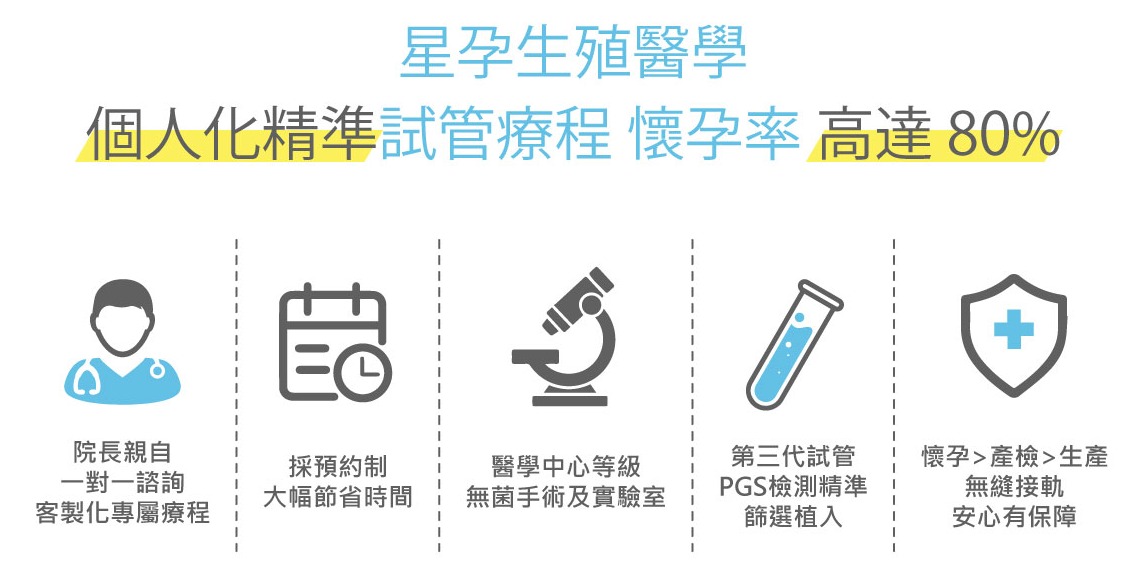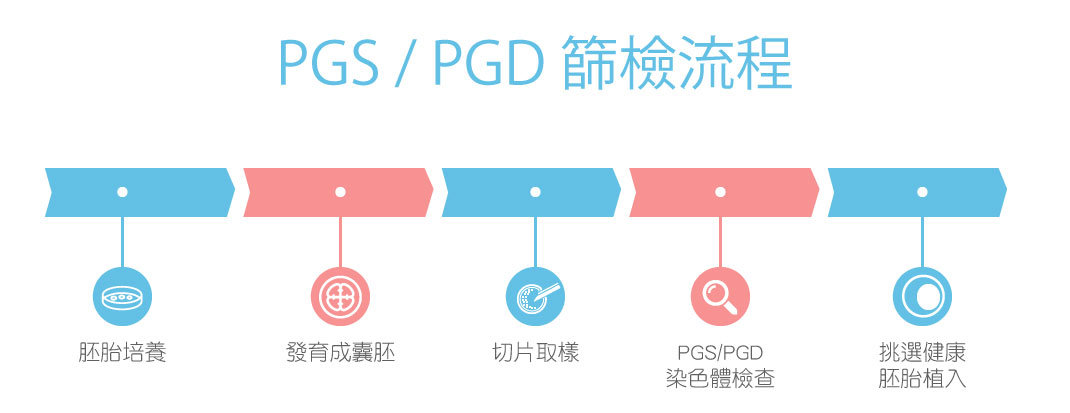胚胎著床前基因篩檢 PGS(PGT-A) / PGD(PGT-M)
什麼是胚胎著床前基因篩檢PGS(PGT-A)?
胚胎著床前基因篩檢PGS (Pre-implantation Genetic Screening)是一種可以在植入胚胎前就將胚胎23對染色體做評估的基因科技。運用PGS可以在做胚胎尚未植入前,檢查胚胎是否存在染色體異常(如染色體數量過多或過少)植入染色體正常的胚胎,不但可以提昇懷孕率,也才能夠生出健康寶寶。
什麼是胚胎著床前基因診斷PGD(PGT-M)?
然而PGS 篩檢主要是檢查染色體的數量和結構是否異常,無法針對單一染色體上的特定基因進行檢測,有些遺傳性疾病無法從PGS檢測出來,此時需要透過PGD等檢測才能篩檢出染色體異常的問題。PGD (Pre-implantation Genetic Diagnosis)是一種在執行胚胎植入前進一步分析胚胎中是否帶有特定的單基因遺傳疾病或染色體異常的診斷技術,可以避免植入患有基因疾病或染色體異常的胚胎,包括單一基因缺陷,如體染色體隱性、顯性和性聯遺傳的疾病,減少生出異常寶寶的機率。
PGT-A 和 PGT-M 是對傳統 PGS 和 PGD 的術語正名,以更精確且專業術語描述避免與其他檢測混淆,更加契合現代輔助生殖技術的需求。
為什麼要做PGS(PGT-A) 或PGD(PGT-M)?
1. 降低流產風險:植入前篩選出健康的胚胎,有助於減少因染色體異常導致流產。
2. 提高懷孕成功率:通過染色體篩檢,選擇優質的胚胎植入,更容易成功著床,適合高齡的女性及多次試管失敗者。
3. 預防遺傳疾病:對於有家族病史的夫婦,PGD 能避免特定遺傳疾病的傳遞,確保寶寶的健康。
(案例分享:PGS / PGD案例分享-連續試管都失敗,32歲女如何如願當媽媽?)
星孕第三代試管嬰兒成功率達80%
星孕生殖醫學中心鍾繼賢院長長年致力於生殖內分泌暨不孕症、試管嬰兒及卵巢相關臨床領域,擅長腹腔鏡及子宮鏡手術,在婦科、產科、不孕症醫學三大領域都用心鑽研,提供個人化精準試管嬰兒療程,以第三代試管嬰兒胚胎著床前染色體篩檢(PGS)提高懷孕率至八成以上。
星孕可以針對已知有特殊家族性遺傳疾病病史的夫妻,在做試管嬰兒時,胚胎尚未放入子宮前,以特製專屬探針偵測胚胎是否帶有該特殊遺傳疾病基因,可以偵測超過400種的遺傳疾病基因,避免家族遺傳基因的傳遞。
 PGS(PGT-A) 及 PGD(PGT-M) 適用對象
PGS(PGT-A) 及 PGD(PGT-M) 適用對象
PGS
1.年齡較大的婦女(通常35歲以上)。
2.多次試管嬰兒植入失敗。
3.有反覆流產病史且懷疑染色體異常者。
4.想要提高胚胎植入成功率的患者。
5.不孕夫妻希望排除染色體因素影響。
PGD
1.家族中有單基因遺傳病史的夫婦(如海洋性貧血、僵直性脊椎炎)。
2.夫妻雙方或其中一人為遺傳病疾病者。
3.曾有多次流產,且確認與單基因異常有關,希望透過篩檢提高懷孕率。
4.生過患有遺傳性疾病的寶寶,希望避免再次發生。
PGS(PGT-A) 或 PGD(PGT-M) 可篩檢的疾病
1.海洋性貧血(Thalassemia)
2.脊髓肌肉萎縮症(Spinal muscular atrophy)
3.血友病(Hemophilia)
4.小腦萎縮症(Spinocerebellar Atrophy)
5.僵直性脊椎炎(Ankylosing Spondylitis)
6.甘迺迪氏症(又稱脊髓延髓性肌肉萎縮症)
7.非酮性高苷胺酸血症(Nonketotic hyperglycinemia)
8.少汗性外胚層發育不良(XLHED)
9.澱粉樣多發性神經病變(Familial Amyloidotic Polyneuropath)
10. 先天性紅綠色盲(Color Blindness)
11. 無虹膜症(Aniridia)
12. 先天性腎上腺增生症(簡稱CAH)
13. 軟骨不全症(ACH)
14. 神經纖維瘤第一型(Neurofibromatosis type 1)
15. 第二型黏多醣症(Mucopolysaccharidosis II,簡稱 MPS-II)
16. 法布瑞氏症(Fabry Disease)
17. 亨汀頓氏舞蹈症(Huntington Disease)
18. 自體顯性多囊性腎疾病(ADPKD)
PGS(PGT-A) 或 PGD(PGT-M) 費用
PGD費用因疾病的種類、基因疾病篩查的複雜性,費用約每個基因約8-15萬元。特殊或罕見基因病檢測可能需額外訂製試劑,費用則會更高。
| 項目 | PGS / PGT-A 胚胎植入前染色體篩檢 | PGD / PGT-M 胚胎植入前基因診斷 |
| 主要目的 | 增加健康胚胎植入成功率,減少染色體異常導致的風險 | 預防特定遺傳疾病傳遞給下一代 |
| 篩檢內容 |
- 染色體數目異常(如唐氏症) - 染色體結構異常 |
- 單一基因缺陷之遺傳病(如海洋性貧血) |
| 適用族群 | 年齡較大(35歲以上)、流產史、多次試管失敗者 | 有家族遺傳病史、單一缺陷基因攜帶者 |
| 費用 | 按胚胎數量計費,平均每個胚胎約1.8萬元 | 複雜度較高,平均每個基因篩查約8-15萬元 |
PGS(PGT-A) 或 PGD(PGT-M) 流程
1.胚胎培養:利用試管嬰兒技術將卵子與精子結合,培養至第 5 天形成囊胚。接著運用電腦定位胚胎雷射做雷射輔助孵化,在胚胎的透明帶上面打洞,好讓胚胎從透明帶中脫殼而出 (孵化—hatch out)。
2.胚胎取樣:根據胚胎的成長狀況,我們會在第五天或是第六天進行胚胎切片,切取3-5個細胞送去做染色體檢查。胚胎切片由於是脫殼出來的少部分細胞,因此對胚胎本身傷害極小。
3.基因檢測:運用高通量測序或微陣列技術分析染色體數目及基因異常。取囊胚的滋胚層細胞進行基因分析,不影響胚胎發育。
4.結果評估:醫師根據篩檢結果,選擇健康胚胎進行植入。
5.胚胎植入:將篩選出的健康胚胎植入母體子宮。
PGS 和 PGD 可降低流產風險及避免生育出遺傳疾病的下一代,幫助高風險夫婦挑選更健康的胚胎進行植入。然而,這些技術仍有一定的限制。例如,PGS 主要檢測染色體的數量和結構,無法篩查單一基因疾病或極小染色體片段的異常。而 PGD 雖能針對特定遺傳疾病進行篩選,但對未檢測的基因變異和某些染色體異常仍可能無法涵蓋。
因此,接受 PGS 或 PGD 檢測後,提醒仍需在懷孕期間進行正常的產檢,包括絨毛膜取樣或羊水穿刺等,以進一步確認胎兒的健康狀況,全面保障孕期的安全與寶寶的健康。

PGS(PGT-A) 或 PGD(PGT-M) 常見問題
1:做PGS或PGD檢測後可以提升懷孕成功率嗎?
PGS 可以提升成功率降低流產風險,PGD 可避免特定遺傳疾病。
2:PGS或PGD 檢測會影響胚胎健康嗎?
檢測會由專業胚胎師完成切片送檢,不會影響胚胎健康。
3:所有的胚胎都能做PGS或PGD檢測嗎?
並非所有胚胎皆能夠進行PGS或PGD檢測,原則上以形成至一定等級的囊胚才能進行切片,否則可能影響胚胎後續存活率及懷孕率。
4:做了 PGS 或 PGD,就能保證生下健康的寶寶嗎?
無論是PGS還是PGD技術,都各自有一些基因異常是無法被篩檢出來的,所以懷孕後的產檢還是要認真做足才能確保小孩健康成長喔!
5:一定要做 PGS 或 PGD 檢測嗎?
是否進行檢測取決於個人情況。如有家族遺傳疾病史或反覆流產的人就建議考慮此做法。
為何選擇星孕生殖醫學中心來做PGS / PGD?
專業醫療團隊
星孕生殖醫學中心結合先進的生殖醫學技術,專注於不孕症、人工受孕和試管嬰兒等領域。其專業團隊致力於根據患者的身體狀況設計個人化療程,幫助實現生育計畫。
尖端醫療設備
診所配備先進的實驗室與醫療儀器,包括10000級無菌環境、高解析度超音波及多功能培養箱等,確保胚胎與卵子的培養過程達到最佳條件,進一步提高懷孕率。
一站式服務與便捷性
星孕結合醫學中心的專業水平與社區診所的便利性,患者可以在舒適的環境中完成整套療程,包括術前檢查、取卵手術和術後恢復,無需頻繁往返多個機構,節省時間與精力。
高成功率與個性化照護
星孕以專業的胚胎培養技術和精確的植入操作,大幅提升試管嬰兒及凍卵的成功率。根據患者的卵巢功能和健康狀態,量身打造療程計畫,確保療程對生活影響最小化。我們有一對一的專業諮詢護理師,在療程期間照護好未來媽媽的生理與心理,隨時回應解決您提出的任何問題,確保您安心的進行療程。


